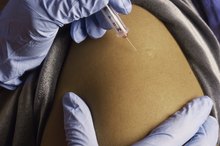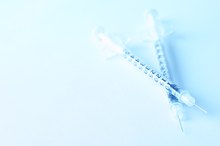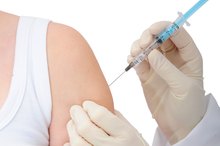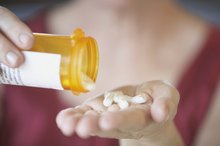Types of Birth Control for Ovarian Cysts
Ovarian cysts are common in women during reproductive years 1. Ovarian cysts are usually functional meaning they develop from the egg containing follicle that matures during the menstrual cycle, according to “A Gynecologist’s Second Opinion,” by William Parker, M.D. Suppressing ovulation may help prevent the formation of ovarian cysts, but the evidence is not conclusive. Studies show no benefit in treating already formed cysts with birth control pills.
Monophasic OCPs
Monophasic birth control pills contain the same amount of estrogen and progesterone in each pill that’s taken during the month. Monophasic oral contraceptive pills (OCPs) are manufactured in both low-dose estrogen and high-dose estrogen form. According to a 2001 ESHRE ( European Society of Human Reproduction and Endocrinology) report published in Human Reproduction, 20 micrograms of synthetic estrogen may be the lower limit of effectiveness in follicle suppression. The article states that with low-dose estrogen pills, follicles (which may turn into cysts) larger than 10 millimeters were found in the majority of cycles.
Birth control pills containing 30 micrograms of estrogen were more effective than those with very low doses of estrogen at suppressing cyst formation. A study reported in 2003 in Obstetrics and Gynecology found that oral contraceptives containing 35 micrograms of estrogen or higher suppressed ovarian cyst formation, but lower dose estrogen OCPs did not and multiphasic pills (pills containing varying amounts of hormone to mimic a natural cycle) OCPs did not.
Very low dose OCPs currently on the market include Mircette, Allesse and Lo-Estrin, which contain 20 micrograms of estrogen. Ovcon-35, Ortho-Novum 1/35, Demulen 1/35 and Norinyl 1/35 contain 35 micrograms of estrogen. Higher dose OCPs that contain 50 micrograms of estrogen include Norinyl 1/50, Ortho Novum 1/50 and Zovia 1/50E.
- Monophasic birth control pills contain the same amount of estrogen and progesterone in each pill that’s taken during the month.
- A study reported in 2003 in Obstetrics and Gynecology found that oral contraceptives containing 35 micrograms of estrogen or higher suppressed ovarian cyst formation, but lower dose estrogen OCPs did not and multiphasic pills (pills containing varying amounts of hormone to mimic a natural cycle) OCPs did not.
Multiphasic OCPs
Bromocriptine as a Cause of Twins
Learn More
Multiphasic birth control pills use varying amounts of hormones during the month to mimic a natural ovulatory cycle. Biphasic and multiphasic birth control pills are more effective in preventing cysts if they contain a higher dose of estrogen. A 1992 study published in by the Fred Hutchinson Cancer Research Center in Seattle, found that triphasic OCPs are as effective as monophasic OCPs, whether low or high dose.
Triphasic OCPs that start with less than 35 micrograms of estrogen include 20 Estrostep Fe; Triphasil, Trivora and Tri-Levlen go from 30 to 40 micrograms; Ortho-Novum 10/11, Jenest, Ortho Novum 7/7/7 and Ortho Tri-Cyclen all contain 35 micrograms of estrogen throughout the entire month..
- Multiphasic birth control pills use varying amounts of hormones during the month to mimic a natural ovulatory cycle.
- Triphasic OCPs that start with less than 35 micrograms of estrogen include 20 Estrostep Fe; Triphasil, Trivora and Tri-Levlen go from 30 to 40 micrograms; Ortho-Novum 10/11, Jenest, Ortho Novum 7/7/7 and Ortho Tri-Cyclen all contain 35 micrograms of estrogen throughout the entire month..
Progestin-Only OCPs
Follicle stimulating hormone (FSH) stimulates follicle growth, including follicles that become functional cysts. Estrogen suppresses FSH. Because progestin-only pills contain no estrogens and because synthetic or natural progesterone alone doesn’t suppress estrogen levels, progestin-only birth control pills are less likely to prevent functional cysts. The 2001 ESHRE study in Human Reproduction showed that cysts developed in 10 to 20 percent of cycles in women taking progestin-only pills. Micronor and Ovrette are two examples of progestin-only OCPs.
- Follicle stimulating hormone (FSH) stimulates follicle growth, including follicles that become functional cysts.
- Because progestin-only pills contain no estrogens and because synthetic or natural progesterone alone doesn’t suppress estrogen levels, progestin-only birth control pills are less likely to prevent functional cysts.
Continuous Dose OCPs
Does Vitamin C Make Birth Control Less Effective?
Learn More
Some new birth control pills are meant to be taken continuously. None of the pills are placebos; all contain drugs. Follicles and cysts may begin to form during the week that inert pills are taken, so continuous dose pills are more likely to prevent cyst formation. Brands meant to be taken continuously include Lybrel, which is taken for one year and Seasonique, which includes a week of low-dose estrogen every three months and Seasonale, which contains a week of placebo pills.
- Some new birth control pills are meant to be taken continuously.
- Brands meant to be taken continuously include Lybrel, which is taken for one year and Seasonique, which includes a week of low-dose estrogen every three months and Seasonale, which contains a week of placebo pills.
Related Articles
References
- Ovarian and endometrial function during hormonal contraception ;The ESHRE Capri Workshop Group; July 2001
- Centers for Disease Control and Prevention. Contraception. Updated November 1, 2019.
- Stewart M, Black K. Choosing a combined oral contraceptive pill. Aust Prescr. 2015;38(1):6–11. doi:10.18773/austprescr.2015.002
- Allen RH. Combined estrogen-progestin oral contraceptives: Patient selection, counseling, and use. Updated July 9, 2019.
- Christin-Maitre S. History of oral contraceptive drugs and their use worldwide. Best practice & research. Clinical Endocrinology & Metabolism. 2013 Feb 28; 27(1):3-12. doi:10.1016/j.beem.2012.11.004
Resources
Writer Bio
A registered nurse with more than 25 years of experience in oncology, labor/delivery, neonatal intensive care, infertility and ophthalmology, Sharon Perkins has also coauthored and edited numerous health books for the Wiley "Dummies" series. Perkins also has extensive experience working in home health with medically fragile pediatric patients.









